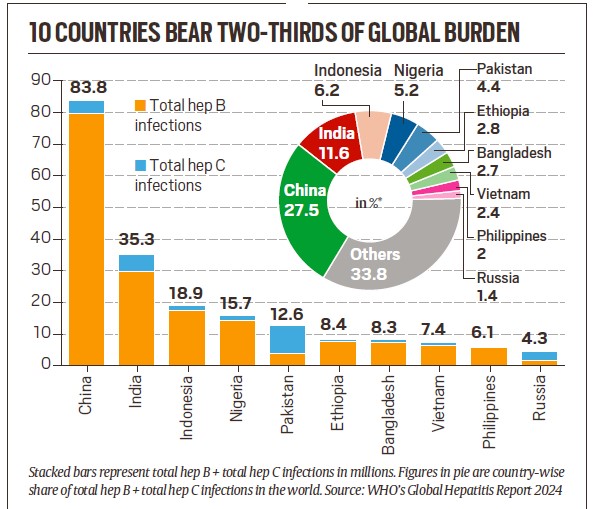Globally, an estimated 1.3 million people died of viral hepatitis in 2022 (as compared to 1.1 million in 2019), even as its incidence — number of new cases in a year — went down to 2.2 million in 2022 (as compared to 2.5 million in 2019). Even more concerning is the fact that diagnosis and treatment for viral hepatitis remained extremely low.

What is viral hepatitis?
There are five hepatitis viruses that cause liver disease in humans. Hepatitis A and E are transmitted through contaminated food and water, and result in weeks-long symptoms such as fever, abdominal pain, jaundice (yellowing of skin), dark urine, and pale stools.
The WHO report, however, pertains to the blood-borne hepatitis B (hep B) and hepatitis C (hep C) viruses. Some of these viruses may result in a short-term infections which resolve on their own. But others can lead to chronic life-long disease, cause cirrhosis (permanent scarring of the liver, making it less efficient), and increase the risk of liver cancer.
Hep B can be prevented by vaccination, while hep C can be cured with medication. The report does not consider hepatitis D that can only infect those who are already infected with hep B. It can thus be prevented by vaccinating against hep B.
What does the report say about India?
India has the world’s second highest prevalence of viral hepatitis cases, accounting for over 11% of the global burden, the report found.
Globally, of the 254 million people living with hep B in 2022, India accounted for 29 million cases, second only to China (79 million cases). Of the 50 million people living with hep C in the world, India accounted for 5.5 million cases, just behind Pakistan’s 8.8 million cases. The diagnosis of viral hepatitis also remained abysmally low. According to the report, only 2.4% hep B cases and about 28% hep C cases were diagnosed.
Story continues below this ad
 With regard to hep C, the WHO report says that India is one of 10 countries where 80% infections are among injection drug users.
With regard to hep C, the WHO report says that India is one of 10 countries where 80% infections are among injection drug users.
This is despite there existing a national programme that offers free diagnosis and treatment for hep B and C. Dr S K Sarin, vice chancellor of the Institute of Liver and Biliary Disease (ILBS), and one of the people behind the country’s national programme, said that even though the programme was launched in 2018, its reach remains limited. “People have not been utilising the free diagnostics and treatment that is offered,” he said.
What is driving up viral hepatitis cases in India?
Viral hepatitis can be transmitted through contaminated blood transfusions, or through contaminated needles.
Dr Sarin, however, said that India’s hep B cases are driven up by mother-to-child transmission. “Almost 90% of hep B cases in India are transmitted from mother to child, because most blood banks now provide safe blood, and needle-stick transmission in healthcare workers is limited because almost everyone is vaccinated,” he said.
With regard to hep C, the WHO report says that India is one of 10 countries where 80% infections are among injection drug users.
What are the challenges in dealing with viral hepatitis?
There are more challenges to controlling hep B (than C), Dr Sarin said. At least three things have to be ensured. “First, all newborns will have to be fully vaccinated against hep B. Second, adults who have not been immunised should also be given the shot. And all those who are diagnosed with the infection should be put on treatment,” he said.
Story continues below this ad
The hep B vaccine was rolled out for children in 2007-08, under the government’s universal immunisation programme. But a 2019 study found that its coverage varied between 41% and 62%. The 2018 National Viral Hepatitis Control Programme also makes provisions for vaccination of people at high risk of contracting hep B, such as healthcare workers.
When it comes to treatment, Dr Sarin said: “The treatment for hep B is done by specialists according to an international guideline. The problem is that the parameters mentioned in the guideline for initiating treatment exclude seven to eight of the 10 people who are diagnosed with the infection. There is a need to adopt a ‘treat all’ approach just like we have done for HIV — meaning anyone diagnosed with the condition should be offered treatment immediately.”
The antiviral treatment for hep B slows the ability of the virus to damage the liver.
With regard to hep C, according to Dr Sarin, just making medicines available is half the battle won. “The available treatment can cure hep C, and has a good efficacy of 80% to 90%. Unlike hep B, for which medicines have to be taken for life, the treatment for hep C goes on for a shorter duration [12 to 24 weeks],” he explained.
Story continues below this ad
How does India’s response to viral hepatitis compare with that to TB?
Crucially, despite the infection killing almost as many people as TB, it does not receive nearly as much attention. Globally, treatment coverage for TB was estimated to be around 70% in 2022, but the coverage for hep B and C was only 3% and 20% respectively.
In India, the numbers of deaths due to viral hepatitis aren’t comparable to TB, which killed an estimated 3.31 lakh people in 2022, but the disparity in treatment coverage remained stark. The report found that none of the diagnosed patients received treatment for hep B, while just 21% received treatment for hep C. In comparison, 95% of those diagnosed with TB in India were put on therapy.
Shortage of drugs is not the problem. According to the report, India has among the cheapest drugs and diagnostics available. For example, the cost of a rapid diagnostic test for hep B in India, at $0.09, was the lowest among the countries that reported the figure. Similarly, the cost of a rapid diagnostic test for hep C was only $0.21 in India, again the lowest among countries that reported the figure.
In India, the TDF treatment for hep B is also available for lower than the global benchmark price of $ 2.40 per month. Moreover, a 12-week course to cure hep C, for which the global benchmark price is $60, is available for cheaper in India. In fact, several Indian drug makers manufacture generic versions of these medicines.



 With regard to hep C, the WHO report says that India is one of 10 countries where 80% infections are among injection drug users.
With regard to hep C, the WHO report says that India is one of 10 countries where 80% infections are among injection drug users.




































